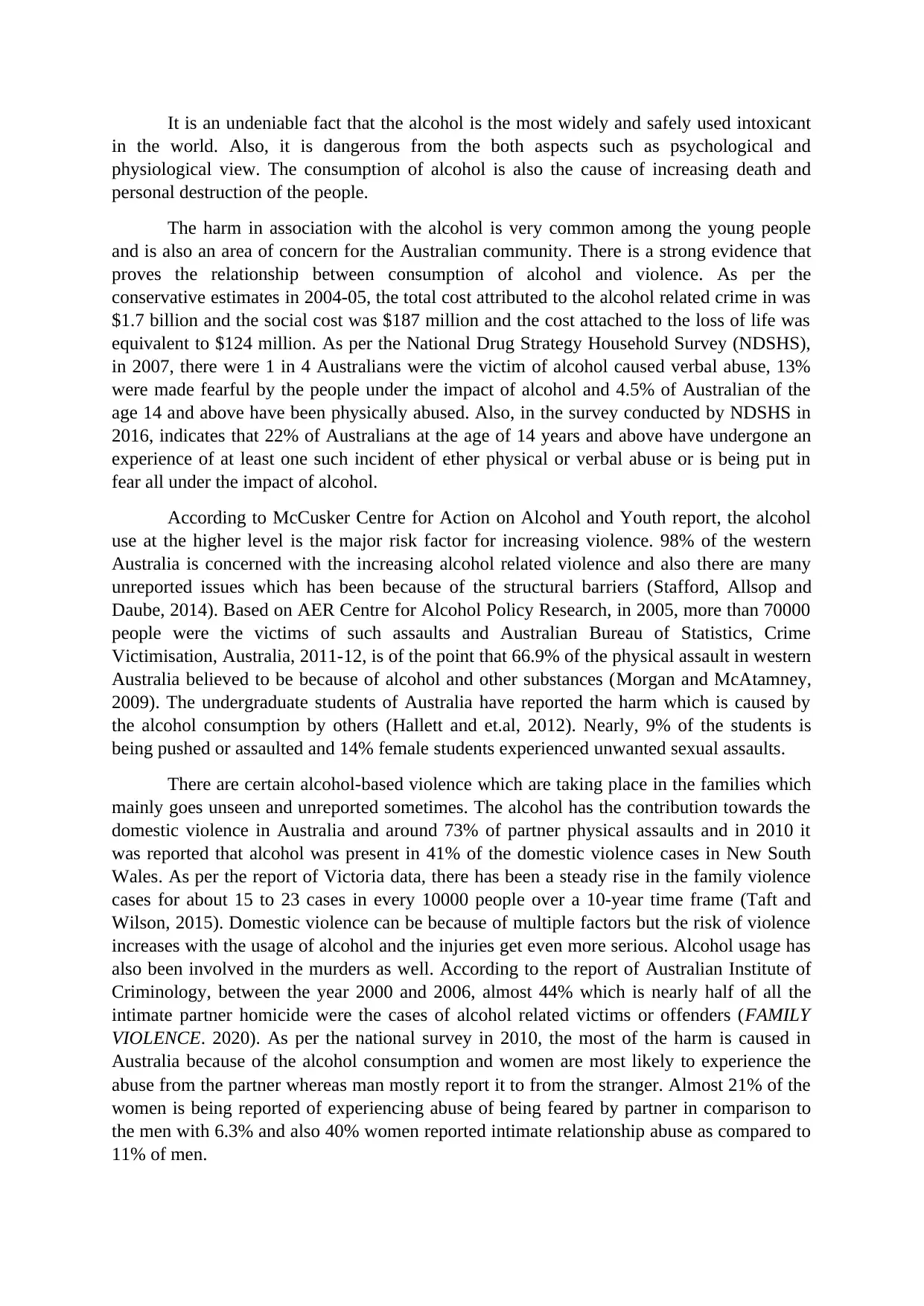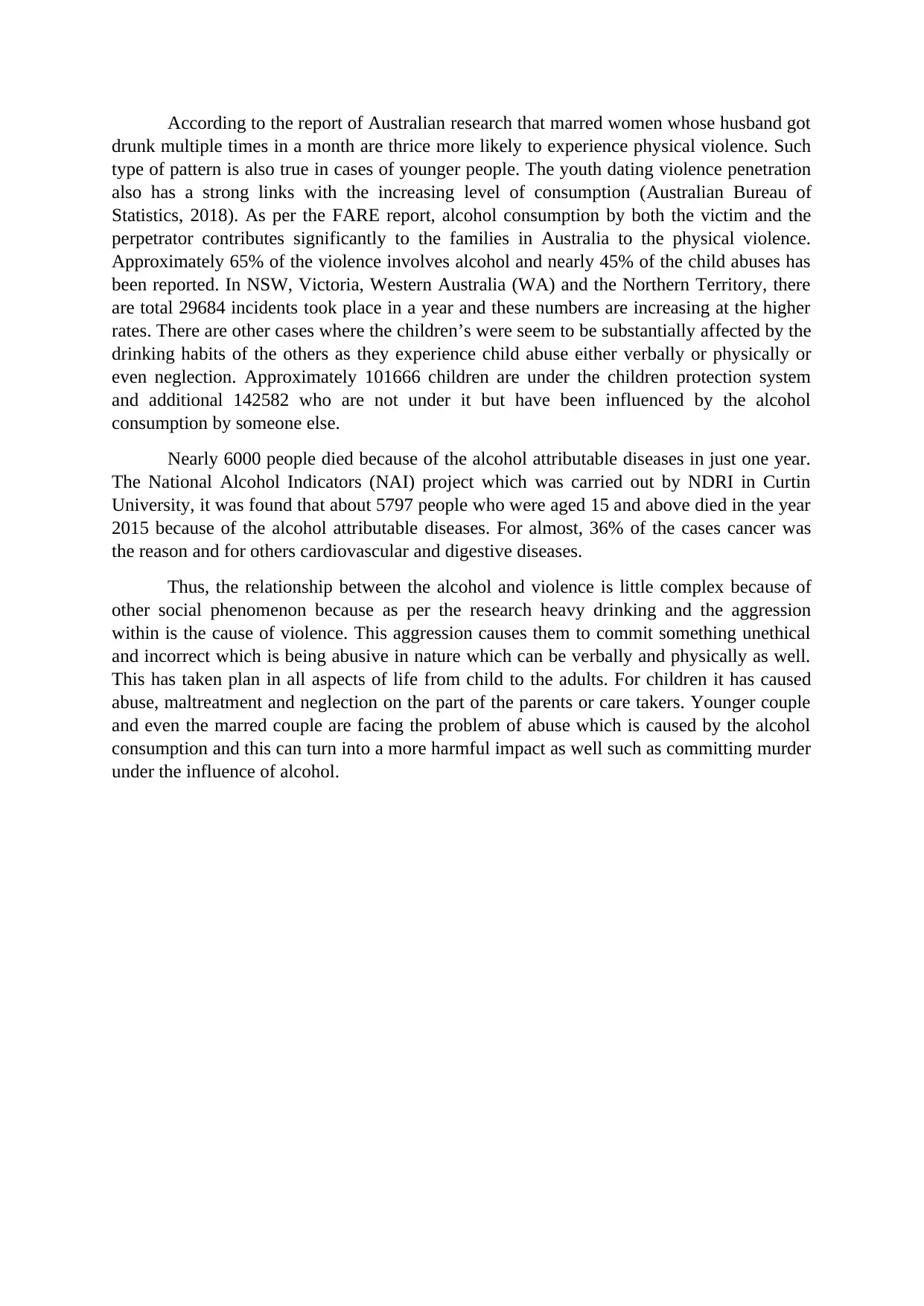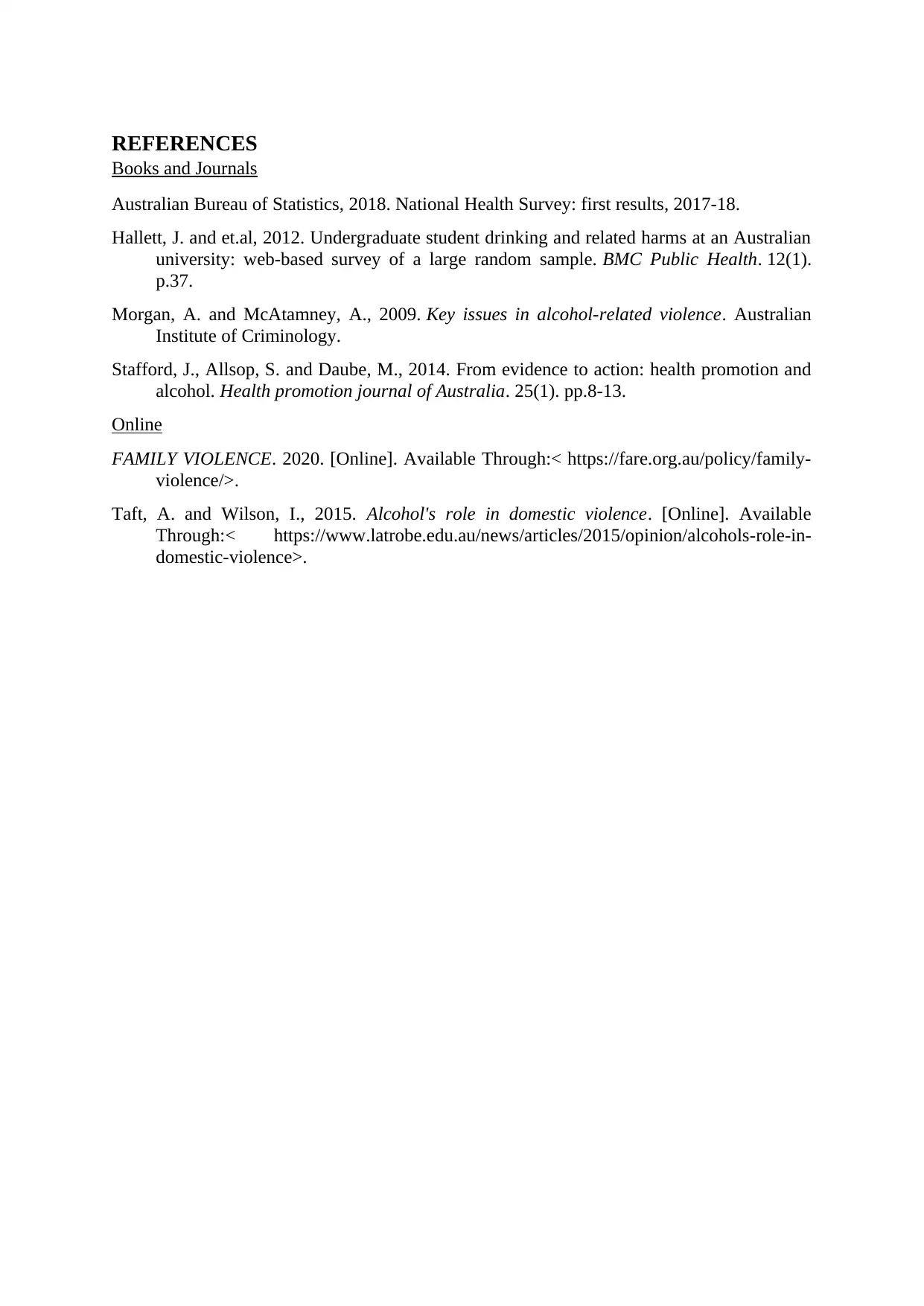Alcohol's Role in Domestic Violence: An Australian Perspective
VerifiedAdded on 2023/01/11
|5
|1310
|83
Report
AI Summary
This report delves into the undeniable correlation between alcohol consumption and violence, particularly within the Australian context. It highlights the widespread use of alcohol and its dangerous psychological and physiological effects, including its contribution to increasing death rates and personal destruction. The report presents evidence from various surveys and studies, such as the National Drug Strategy Household Survey (NDSHS) and the McCusker Centre for Action on Alcohol and Youth, to illustrate the prevalence of alcohol-related violence, including verbal and physical abuse, and the significant social and economic costs associated with it. The report also explores the connection between alcohol and domestic violence, citing statistics on partner assaults and family violence cases, and the involvement of alcohol in intimate partner homicides. Furthermore, it examines the intergenerational aspects of alcoholism and violence, and the impact of parental alcohol consumption on children. The report concludes by emphasizing the complex nature of the relationship between alcohol and violence and the need for a comprehensive approach to address the issue.

Alcohol causes violence
Paraphrase This Document
Need a fresh take? Get an instant paraphrase of this document with our AI Paraphraser

TABLE OF CONTENTS
REFERENCES...........................................................................................................................5
REFERENCES...........................................................................................................................5

It is an undeniable fact that the alcohol is the most widely and safely used intoxicant
in the world. Also, it is dangerous from the both aspects such as psychological and
physiological view. The consumption of alcohol is also the cause of increasing death and
personal destruction of the people.
The harm in association with the alcohol is very common among the young people
and is also an area of concern for the Australian community. There is a strong evidence that
proves the relationship between consumption of alcohol and violence. As per the
conservative estimates in 2004-05, the total cost attributed to the alcohol related crime in was
$1.7 billion and the social cost was $187 million and the cost attached to the loss of life was
equivalent to $124 million. As per the National Drug Strategy Household Survey (NDSHS),
in 2007, there were 1 in 4 Australians were the victim of alcohol caused verbal abuse, 13%
were made fearful by the people under the impact of alcohol and 4.5% of Australian of the
age 14 and above have been physically abused. Also, in the survey conducted by NDSHS in
2016, indicates that 22% of Australians at the age of 14 years and above have undergone an
experience of at least one such incident of ether physical or verbal abuse or is being put in
fear all under the impact of alcohol.
According to McCusker Centre for Action on Alcohol and Youth report, the alcohol
use at the higher level is the major risk factor for increasing violence. 98% of the western
Australia is concerned with the increasing alcohol related violence and also there are many
unreported issues which has been because of the structural barriers (Stafford, Allsop and
Daube, 2014). Based on AER Centre for Alcohol Policy Research, in 2005, more than 70000
people were the victims of such assaults and Australian Bureau of Statistics, Crime
Victimisation, Australia, 2011-12, is of the point that 66.9% of the physical assault in western
Australia believed to be because of alcohol and other substances (Morgan and McAtamney,
2009). The undergraduate students of Australia have reported the harm which is caused by
the alcohol consumption by others (Hallett and et.al, 2012). Nearly, 9% of the students is
being pushed or assaulted and 14% female students experienced unwanted sexual assaults.
There are certain alcohol-based violence which are taking place in the families which
mainly goes unseen and unreported sometimes. The alcohol has the contribution towards the
domestic violence in Australia and around 73% of partner physical assaults and in 2010 it
was reported that alcohol was present in 41% of the domestic violence cases in New South
Wales. As per the report of Victoria data, there has been a steady rise in the family violence
cases for about 15 to 23 cases in every 10000 people over a 10-year time frame (Taft and
Wilson, 2015). Domestic violence can be because of multiple factors but the risk of violence
increases with the usage of alcohol and the injuries get even more serious. Alcohol usage has
also been involved in the murders as well. According to the report of Australian Institute of
Criminology, between the year 2000 and 2006, almost 44% which is nearly half of all the
intimate partner homicide were the cases of alcohol related victims or offenders (FAMILY
VIOLENCE. 2020). As per the national survey in 2010, the most of the harm is caused in
Australia because of the alcohol consumption and women are most likely to experience the
abuse from the partner whereas man mostly report it to from the stranger. Almost 21% of the
women is being reported of experiencing abuse of being feared by partner in comparison to
the men with 6.3% and also 40% women reported intimate relationship abuse as compared to
11% of men.
in the world. Also, it is dangerous from the both aspects such as psychological and
physiological view. The consumption of alcohol is also the cause of increasing death and
personal destruction of the people.
The harm in association with the alcohol is very common among the young people
and is also an area of concern for the Australian community. There is a strong evidence that
proves the relationship between consumption of alcohol and violence. As per the
conservative estimates in 2004-05, the total cost attributed to the alcohol related crime in was
$1.7 billion and the social cost was $187 million and the cost attached to the loss of life was
equivalent to $124 million. As per the National Drug Strategy Household Survey (NDSHS),
in 2007, there were 1 in 4 Australians were the victim of alcohol caused verbal abuse, 13%
were made fearful by the people under the impact of alcohol and 4.5% of Australian of the
age 14 and above have been physically abused. Also, in the survey conducted by NDSHS in
2016, indicates that 22% of Australians at the age of 14 years and above have undergone an
experience of at least one such incident of ether physical or verbal abuse or is being put in
fear all under the impact of alcohol.
According to McCusker Centre for Action on Alcohol and Youth report, the alcohol
use at the higher level is the major risk factor for increasing violence. 98% of the western
Australia is concerned with the increasing alcohol related violence and also there are many
unreported issues which has been because of the structural barriers (Stafford, Allsop and
Daube, 2014). Based on AER Centre for Alcohol Policy Research, in 2005, more than 70000
people were the victims of such assaults and Australian Bureau of Statistics, Crime
Victimisation, Australia, 2011-12, is of the point that 66.9% of the physical assault in western
Australia believed to be because of alcohol and other substances (Morgan and McAtamney,
2009). The undergraduate students of Australia have reported the harm which is caused by
the alcohol consumption by others (Hallett and et.al, 2012). Nearly, 9% of the students is
being pushed or assaulted and 14% female students experienced unwanted sexual assaults.
There are certain alcohol-based violence which are taking place in the families which
mainly goes unseen and unreported sometimes. The alcohol has the contribution towards the
domestic violence in Australia and around 73% of partner physical assaults and in 2010 it
was reported that alcohol was present in 41% of the domestic violence cases in New South
Wales. As per the report of Victoria data, there has been a steady rise in the family violence
cases for about 15 to 23 cases in every 10000 people over a 10-year time frame (Taft and
Wilson, 2015). Domestic violence can be because of multiple factors but the risk of violence
increases with the usage of alcohol and the injuries get even more serious. Alcohol usage has
also been involved in the murders as well. According to the report of Australian Institute of
Criminology, between the year 2000 and 2006, almost 44% which is nearly half of all the
intimate partner homicide were the cases of alcohol related victims or offenders (FAMILY
VIOLENCE. 2020). As per the national survey in 2010, the most of the harm is caused in
Australia because of the alcohol consumption and women are most likely to experience the
abuse from the partner whereas man mostly report it to from the stranger. Almost 21% of the
women is being reported of experiencing abuse of being feared by partner in comparison to
the men with 6.3% and also 40% women reported intimate relationship abuse as compared to
11% of men.
⊘ This is a preview!⊘
Do you want full access?
Subscribe today to unlock all pages.

Trusted by 1+ million students worldwide

According to the report of Australian research that marred women whose husband got
drunk multiple times in a month are thrice more likely to experience physical violence. Such
type of pattern is also true in cases of younger people. The youth dating violence penetration
also has a strong links with the increasing level of consumption (Australian Bureau of
Statistics, 2018). As per the FARE report, alcohol consumption by both the victim and the
perpetrator contributes significantly to the families in Australia to the physical violence.
Approximately 65% of the violence involves alcohol and nearly 45% of the child abuses has
been reported. In NSW, Victoria, Western Australia (WA) and the Northern Territory, there
are total 29684 incidents took place in a year and these numbers are increasing at the higher
rates. There are other cases where the children’s were seem to be substantially affected by the
drinking habits of the others as they experience child abuse either verbally or physically or
even neglection. Approximately 101666 children are under the children protection system
and additional 142582 who are not under it but have been influenced by the alcohol
consumption by someone else.
Nearly 6000 people died because of the alcohol attributable diseases in just one year.
The National Alcohol Indicators (NAI) project which was carried out by NDRI in Curtin
University, it was found that about 5797 people who were aged 15 and above died in the year
2015 because of the alcohol attributable diseases. For almost, 36% of the cases cancer was
the reason and for others cardiovascular and digestive diseases.
Thus, the relationship between the alcohol and violence is little complex because of
other social phenomenon because as per the research heavy drinking and the aggression
within is the cause of violence. This aggression causes them to commit something unethical
and incorrect which is being abusive in nature which can be verbally and physically as well.
This has taken plan in all aspects of life from child to the adults. For children it has caused
abuse, maltreatment and neglection on the part of the parents or care takers. Younger couple
and even the marred couple are facing the problem of abuse which is caused by the alcohol
consumption and this can turn into a more harmful impact as well such as committing murder
under the influence of alcohol.
drunk multiple times in a month are thrice more likely to experience physical violence. Such
type of pattern is also true in cases of younger people. The youth dating violence penetration
also has a strong links with the increasing level of consumption (Australian Bureau of
Statistics, 2018). As per the FARE report, alcohol consumption by both the victim and the
perpetrator contributes significantly to the families in Australia to the physical violence.
Approximately 65% of the violence involves alcohol and nearly 45% of the child abuses has
been reported. In NSW, Victoria, Western Australia (WA) and the Northern Territory, there
are total 29684 incidents took place in a year and these numbers are increasing at the higher
rates. There are other cases where the children’s were seem to be substantially affected by the
drinking habits of the others as they experience child abuse either verbally or physically or
even neglection. Approximately 101666 children are under the children protection system
and additional 142582 who are not under it but have been influenced by the alcohol
consumption by someone else.
Nearly 6000 people died because of the alcohol attributable diseases in just one year.
The National Alcohol Indicators (NAI) project which was carried out by NDRI in Curtin
University, it was found that about 5797 people who were aged 15 and above died in the year
2015 because of the alcohol attributable diseases. For almost, 36% of the cases cancer was
the reason and for others cardiovascular and digestive diseases.
Thus, the relationship between the alcohol and violence is little complex because of
other social phenomenon because as per the research heavy drinking and the aggression
within is the cause of violence. This aggression causes them to commit something unethical
and incorrect which is being abusive in nature which can be verbally and physically as well.
This has taken plan in all aspects of life from child to the adults. For children it has caused
abuse, maltreatment and neglection on the part of the parents or care takers. Younger couple
and even the marred couple are facing the problem of abuse which is caused by the alcohol
consumption and this can turn into a more harmful impact as well such as committing murder
under the influence of alcohol.
Paraphrase This Document
Need a fresh take? Get an instant paraphrase of this document with our AI Paraphraser

REFERENCES
Books and Journals
Australian Bureau of Statistics, 2018. National Health Survey: first results, 2017‐18.
Hallett, J. and et.al, 2012. Undergraduate student drinking and related harms at an Australian
university: web-based survey of a large random sample. BMC Public Health. 12(1).
p.37.
Morgan, A. and McAtamney, A., 2009. Key issues in alcohol-related violence. Australian
Institute of Criminology.
Stafford, J., Allsop, S. and Daube, M., 2014. From evidence to action: health promotion and
alcohol. Health promotion journal of Australia. 25(1). pp.8-13.
Online
FAMILY VIOLENCE. 2020. [Online]. Available Through:< https://fare.org.au/policy/family-
violence/>.
Taft, A. and Wilson, I., 2015. Alcohol's role in domestic violence. [Online]. Available
Through:< https://www.latrobe.edu.au/news/articles/2015/opinion/alcohols-role-in-
domestic-violence>.
Books and Journals
Australian Bureau of Statistics, 2018. National Health Survey: first results, 2017‐18.
Hallett, J. and et.al, 2012. Undergraduate student drinking and related harms at an Australian
university: web-based survey of a large random sample. BMC Public Health. 12(1).
p.37.
Morgan, A. and McAtamney, A., 2009. Key issues in alcohol-related violence. Australian
Institute of Criminology.
Stafford, J., Allsop, S. and Daube, M., 2014. From evidence to action: health promotion and
alcohol. Health promotion journal of Australia. 25(1). pp.8-13.
Online
FAMILY VIOLENCE. 2020. [Online]. Available Through:< https://fare.org.au/policy/family-
violence/>.
Taft, A. and Wilson, I., 2015. Alcohol's role in domestic violence. [Online]. Available
Through:< https://www.latrobe.edu.au/news/articles/2015/opinion/alcohols-role-in-
domestic-violence>.
1 out of 5
Related Documents
Your All-in-One AI-Powered Toolkit for Academic Success.
+13062052269
info@desklib.com
Available 24*7 on WhatsApp / Email
![[object Object]](/_next/static/media/star-bottom.7253800d.svg)
Unlock your academic potential
Copyright © 2020–2025 A2Z Services. All Rights Reserved. Developed and managed by ZUCOL.





